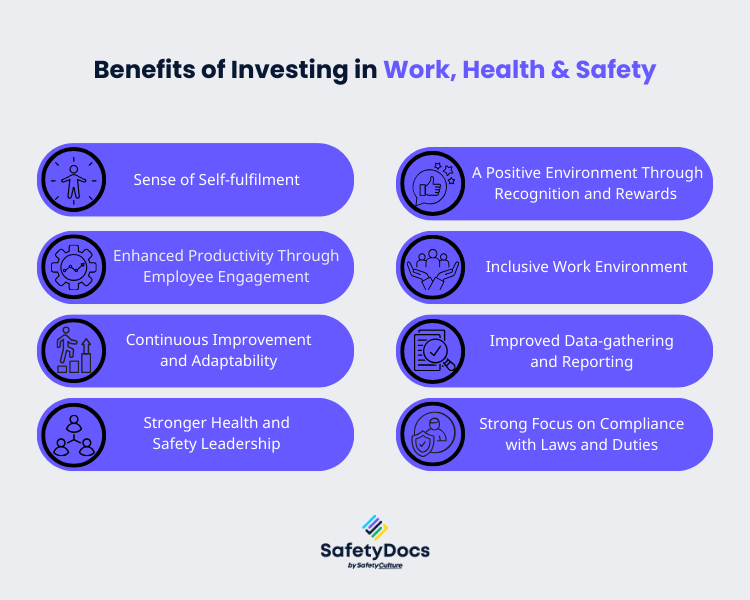The future of Australian workplaces is not just about embracing technological advancements; it's about recognising the interconnectedness of safety, health, and productivity – a triad that will define the success of workplaces. Crafting an environment where these three elements flourish is not just a responsibility but a recipe for sustainable achievement.
This article delves into safety, health, and productivity in the Australian workplace. Additionally, we will delve into the evolving landscape of workplace health and safety (WHS), influenced by shifting work patterns and emerging job structures. Understanding the fundamentals of this triad will help organisations create and maintain a culture of safety, health, and success.

The Future of Work Health and Safety
Here are several key trends and initiatives shaping the landscape:
1. Australian Work Health and Safety Strategy 2023-2033
This strategy by Safe Work Australia aims to drive a nationally cohesive approach to WHS. The Australian Work Health and Safety Strategy 2023–2033 outlines the need to address emerging challenges over the next decade. Australia's workplace health and safety (WHS) laws have seen remarkable advancement since their harmonisation in 2012., but there's still work to do. It introduces specific targets to measure progress:
Reducing Work-related Fatalities
- Target: Decrease worker fatalities caused by traumatic injuries by at least 30%.
- Continued focus on progress achieved in the previous strategy.
- Close monitoring of deaths due to occupational diseases.
Reducing Severe Injury or Illness
- Target: Decrease the frequency of serious claims resulting in one or more weeks off work by at least 20%.
- Renewed efforts to address slowed progress in reducing serious injury and illness.
- The new target is a 15% reduction in the frequency rate of permanent impairments.
- Introduction of a target to reduce overall work-related injury/illness to below 3.5%.
- Aim to eliminate new cases of accelerated silicosis by 2033, with ongoing measures to address the issue.
- Target of 20% reduction in the frequency rate of work-related respiratory diseases.
Increasing Preventative Action
- Implementation of updated workplace exposure standards for over 600 chemicals.
- Safe Work Australia Members to raise awareness among PCBUs (Persons Conducting a Business or Undertaking) about protecting workers from harmful substances.
- Focus on building capability among PCBUs, regulators, and workers to manage psychosocial hazards in the workplace.
- Integration of psychosocial hazard management regulations in WHS laws.
- Enhanced reporting on psychosocial hazards and psychological injuries.
2. Intersecting Challenges
The Australian Work Health and Safety Strategy 2023-2033 also presented persistent and emerging challenges that require collaborative action. The challenges Australia will face over the next decade are intersecting and require integrated solutions. This suggests that a holistic approach to WHS management will be necessary to address these challenges effectively.
Here are the emerging challenges that will influence the future of WHS in Australia:
Technological advancements
The rise of automation, AI, and related technologies is another factor shaping the future of work in Australia. They will change the nature of work and the skills required for work, which will require new approaches to WHS management.
Changing patterns of work
The emergence of new work patterns, such as remote work and flexible work arrangements, is bringing fresh WHS issues. These new work patterns require new approaches to WHS management, including ensuring that workers have access to appropriate equipment and support to work safely from home.
Hybrid work
Hybrid work involves remote and in-person work and is becoming the norm in Australia. This new form of work requires new approaches to WHS management, including ensuring that workers have access to appropriate equipment and support to work safely in remote and in-person office settings.
Ageing and migrant workers
As Australia's population ages and labour shortages increase in specific industries, new WHS risks are anticipated. Mainly, the rise in older and migrant workers from diverse cultural backgrounds presents unique challenges.
Climate change
The escalating climate change increases WHS risks due to extreme weather disruptions and new roles in emerging industries. This evolution introduces hazards like exposure to harmful materials. The surge of infectious diseases necessitates businesses to implement effective control measures.
Complicated supply chains
The global pandemic has intensified the challenges faced by supply chains, necessitating the implementation of comprehensive risk management strategies and proactive measures, particularly in high-risk industries. Strategic planning and effective response capabilities become more critical and paramount for businesses to maintain their resilience.

Bringing Together Safety, Health, and Productivity
Safety, health, and productivity are key to the success of workplaces. Creating a safe working environment where these three elements flourish requires a holistic approach to WHS management that addresses all factors influencing work health and safety.
- Holistic perspective: Safety, health, and productivity are closely intertwined in a thriving work environment. Healthy employees are more motivated and less likely to take sick leave, leading to higher productivity.
- Business impact: Investing in safety and health doesn't just benefit employees; it also positively impacts the business. A healthier workforce means fewer sick days, reducing absenteeism. A safe environment reduces the risk of accidents, saving on potential costs related to workplace incidents. It enhances safety and health, increases employee satisfaction and motivation, and improves efficiency and overall performance. Thus, investing in these areas is a win-win for employees and businesses.
By understanding WHS's key trends and emerging challenges in Australia, organisations can develop effective safety systems to reach the triad of successful workplaces. Here are some benefits that organisations can gain by investing in WHS:
1. Sense of Self-fulfilment
When employees are healthy and safe, they can fully enjoy the benefits of work, including a sense of purpose and self-fulfilment. Supporting employee health and safety helps them to stay productive and motivated. Here are some measures that organisations can take to foster employee health and well-being:
- Promote physical health – A healthy work environment is crucial for employee well-being. Ergonomic workspaces reduce physical stress and prevent injuries. Proper ventilation improves air quality, reducing respiratory conditions. Access to healthy food options promotes nutrition. Wellness initiatives inspire employees to stay active and maintain healthier lifestyles. These elements contribute to employees' physical well-being, productivity, and satisfaction at work.
- Support mental health – Destigmatising mental health challenges is vital to encourage open conversations about mental well-being in the workplace. This openness fosters an understanding and supportive environment where employees feel comfortable asking for help when needed. Resources such as counselling services, mental health workshops, and employee assistance programs can equip employees with the tools and knowledge to effectively manage stress and other mental health conditions.
2. Enhanced Productivity through Employee Engagement
Productivity and creativity in employees thrive when they are actively engaged. Establishing a work environment that prioritises employees and amplifies their voices is crucial for enhancing productivity through engagement.
- Build team members' trust– Promote open communication between team members and managers. Encourage feedback from all stakeholders for improved decision-making. Ensure employees know the latest policies and developments in the organisation.
- Create a culture of collaboration – Encouraging a collaborative work atmosphere helps build team members' trust. This, in turn, improves employee engagement and productivity as people feel more connected and motivated to work together towards the same goal.
3. A Positive Environment Through Recognition and Rewards
Recognising and rewarding employees' hard work and achievements is a powerful way to foster a positive work environment and stimulate continued productivity.
- Appreciating efforts – Acknowledging an employee's hard work can be as simple as a thank you note or a public appreciation during team meetings. This act imparts employees a sense of validation and value.
- Rewarding achievements – Reward systems such as bonuses, promotions, or employee of the month awards serve as tangible acknowledgments of an employee's contributions. These rewards motivate the individual and encourage a competitive spirit within the team.
- Promoting a culture of recognition – Having a culture of recognition in the workplace fosters unity, camaraderie, and a sense of belonging among employees, increasing job satisfaction and reducing turnover rates.
4. Inclusive Work Environment
An inclusive workplace environment helps foster a sense of belonging and acceptance among employees from diverse backgrounds. Since remote work has become more prevalent, employers should take proactive measures to create an equitable workspace, regardless of employees' locations.
- Encourage diversity and inclusion – Create policies that promote diversity and inclusion in the workplace and provide fairness for all. Establishing diversity and inclusion committees can show better cross-cultural understanding between employees from various backgrounds.
- Offer flexible working arrangements - Workers may work in different time zones or locations. Allowing flexible working arrangements will enable employees to work productively and with fewer distractions. This can help them achieve work-life balance.
- Design accessible workstations - Ensuring physical accessibility in the workplace, such as wheelchair-friendly workstations, ramps, elevators, and accessible bathrooms, can enable employees with disabilities to perform their tasks efficiently and independently. Incorporating assistive technology like screen readers, speech-to-text tools, or adjustable desks can empower employees with visual, auditory, or mobility impairments.
5. Stronger Health and Safety Leadership
State and territory governments, industry, organisations, and individuals (including PCBUs and workers) lead in building a health and safety culture and embracing systematic ways to manage WHS risks. As responsible duty holders, PCBUs have the opportunity to invest in enhancing organisational capacity to manage and prevent workplace health and safety incidents effectively.
- Promote the importance of the WHS profession – Acknowledge and value the contributions made by WHS professionals. Invest in their ongoing professional development, such as training or workshops, to promote best practices and stay up-to-date with industry trends.
- Increase training of key leaders in healthy and safe work in practice – Capable leaders with a deep understanding of their WHS obligations play a crucial role in guaranteeing adherence to safety protocols and proficient management of risks.
6. Continuous Improvement and Adaptability
Adapting to changes in the workplace is essential for health and safety management. Reviewing and evaluating systems, processes, and practices helps identify potential hazards and assess risks associated with new or amended activities.
- Conduct regular assessments – Regular assessments or audits offer a systematic approach to identify potential hazards, evaluate existing protocols, and monitor compliance with safety regulations. Furthermore, they act as a feedback mechanism, providing invaluable insights into the effectiveness of implemented strategies, thus fostering a culture of continuous improvement.
- Be flexible to adapt strategies and policies based on changing circumstances – As workplace dynamics evolve, so should safety protocols. Staying up-to-date with the latest industry regulations and trends will ensure that organisations can quickly adopt new measures when necessary.
7. Strong Focus on Compliance with Laws and Duties
Organisations must comply with applicable state and federal laws — from health and safety to industrial relations — to protect employees and employers.
- Promote understanding of legal obligations – Educate managers, supervisors, and staff members on their rights and responsibilities under relevant WHS legislation. Ensure new hires or workers assigned additional duties are also well-versed in these laws.
- Put policies and procedures in place – Establish clear guidelines for WHS management, including reporting systems and regular reviews to ensure compliance with laws.
8. Improved Data-gathering and Reporting
Developing a reliable and timely data collection and reporting system is essential for making informed decisions about health and safety.
- Invest in automated systems – Automated systems can help streamline collecting, managing, and analysing data from various sources, such as incident reports or risk assessments.
- Use reliable data to improve decision-making – Collecting accurate and up-to-date information on incidents, occupational diseases, or hazards helps employers make informed decisions when prioritising resources against risks.

SafetyDocs for the Success of Your Current and Future WHS System
Implementing a WHS system influences its effectiveness and efficiency, determining its level of success. That's why it's essential to have the right tools, such as documents from SafetyDocs by SafetyCulture. We provide the most comprehensive document and template library to help employers, PCBUs, and workers meet their WHS legislative requirements easily. With the emerging changes in the workplace, SafetyDocs provides templates for all types of work, from hazardous chemicals to remote working and much more.
Start staying on top of your WHS system with the following documents:
- Remote & Isolated Work Management Plans
- Policies & Procedures
- Risk Management Plan
- Office Work Safe Operating Procedure
- Safety Management Systems
Contact us today to learn more about SafetyDocs and how it can improve your organisation's safety. Let's work together to prioritise workplace health and safety in Australia!
Our team of experts is dedicated to providing accurate and informative content. Craig Cruickshank, our senior HSEQ advisor at SafetyDocs by SafetyCulture has reviewed this blog post to ensure the highest level of quality.
Learn more about Craig's work on LinkedIn for more industry insights.
Available for instant download and supplied in fully editable MS Word format for use in your business.
Please note that the above information is provided as a comment only and should not be relied on as professional, legal or financial advice.
Share This Article
